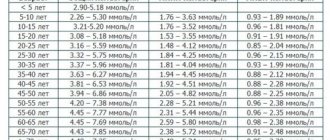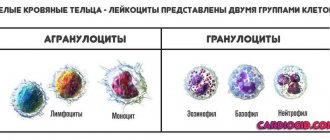General blood tests
03/23/201801/24/2019 Yulia Martynovich (Peshkova) 1494 Views children, lymphocytes
In the results of a blood test, lymphocytes are elevated in the child, what does this mean and what to do? Now you will find out everything. Lymphocytes are a type of heterogeneous group of leukocytes, the main function of which is to protect the human body from pathogens, as well as from its own mutant cells. A pathological condition characterized by an increase in lymphocytes in a child’s blood is called lymphocytosis.
The causes of pathological lymphocytosis in children are different; they can only be determined by the attending physician, taking into account data from laboratory and instrumental examination methods, as well as the clinical picture of the disease.
- 1 The role of lymphocytes in the body 1.1 Classification
- 3.1 Relative lymphocytosis
The norm of lymphocytes in the blood of a child
The content of lymphocytes in the bloodstream depends on the age category of the patient being examined. In a healthy adult, the percentage of these cells varies from 19 to 37 of the total number of leukocytes.
The norms for a child's body vary. The level of lymphocytes is directly affected by the maturity of the baby’s internal systems:
| Age/indicators | min(%) | max(%) |
| 1 day | 12 | 36 |
| 1 Week | 22 | 52 |
| 0.5 years | 42 | 70 |
| 1 year | 45 | 65 |
| 1–6 years | 26 | 55 |
| 7–12 years | 24 | 54 |
| 13–16 years old | 20 | 50 |
Children under one year of age have the highest levels of normal lymphocytes. In the coming years, the concentration of white cells decreases slightly. But when deciphering the result, you should focus not on information on the Internet, but on the range of normal values indicated on the form. Its performance depends on the cell counting method used by a particular laboratory.
Attention! At approximately 4–5 years of age, the levels of lymphocytes and neutrophils become equal. Further, the volume of the latter begins to dominate.
Normal values in children
There are only 18-40% of lymphocytes in the blood. The bulk is located in the peripheral organs of the immune system. A child’s protective functions are just developing, so white blood cells are designed to protect the body from infections. Their number is determined by age. The analysis shows the percentage of lymphocytes to all leukocytes.
The norm for newborns is 6-17.5* 109/l. From 1 to 2 years, the number of white cells is 6-17 * 109/l. From 2 to 4 years the norm is 5.5-15.5 * 109/l. And at 4-6 years old this figure is 5 – 14.5 * 109/l. Up to 10 years, lymphocytes are 4.5 – 13.5 * 109/l.
Why are they rising - what does it mean?
When laboratory tests show an increase in lymphocytes in the blood that exceeds normal values, they speak of lymphocytosis. Doctors note two types of upward changes in the quantitative composition of cells:
- Absolute lymphocytosis. In the presence of a focus of inflammation or another process, excessive formation of cells begins. They are actively produced in the bone marrow.
- Relative lymphocytosis. The number of protective elements remains normal, but the percentage of different types of cells in the bloodstream and directly in the area of inflammation changes. The total number of lymphocytes may appear to increase due to a decrease in other cells.
Know! When an infection enters the body, it is detected almost immediately by the immune system. The immune system is activated, and there are many more protective cells.
Common reasons that influence changes in the quantitative composition of immune cells:
- ARVI, influenza;
- malaria;
- viral hepatitis;
- brucellosis;
- typhoid fever.
With a malignant blood disease (lymphocytic leukemia), the volume of lymphocytes also increases greatly. Among the signs of this condition, the most striking are: an increase in the size of the lymph nodes, liver and spleen, the appearance of weakness, body aches, and the formation of subcutaneous hemorrhages.
In children, the indicator is higher than normal due to the following diseases:
- whooping cough;
- measles;
- rubella;
- chickenpox;
- piggy.
A high level of lymphocytes may persist for some time after getting rid of infectious diseases. Therefore, it is recommended to repeat the blood test only some time after recovery.
Important! Popular pediatrician Evgeniy Komarovsky believes that determining the number of lymphocytes in a blood test in a sick child is an important study. Many years of experience suggest that the most common causes of lymphocytosis are viral infections.
How are lymphocytes formed?
The main organs that form lymphocytes are the thymus (before puberty) and the bone marrow. In them, cells divide and remain until they encounter a foreign agent (virus, bacteria, etc.). There are also secondary lymphoid organs: lymph nodes, spleen and formations in the digestive tract. This is where most lymphocytes migrate. The spleen is also the depot and place of their death.
There are several types of lymphocytes: T, B and NK cells. But they are all formed from a single precursor: a stem cell. It undergoes changes, eventually differentiating into the desired type of lymphocyte.
Reduced lymphocytes in the blood
A reduced count of lymphocytes in the bloodstream is called lymphopenia. When counting the number of cells, the patient’s age must be taken into account.
Just like lymphocytosis, lymphopenia is divided into two types:
- Relative. The decrease in the percentage of lymphocytes is associated with a sharp increase in the number of neutrophils. The problem often occurs against the background of severe pneumonia, as well as due to purulent inflammation.
- Absolute. The level of lymphocytes decreases below the minimum limit value. Characteristic of diseases: systemic lupus erythematosus, severe influenza, aplastic anemia. Also, decreased immunity can be the result of chemotherapy, long-term use of drugs containing cortisol, intoxication and long-term autoimmune diseases.
Thus, a decrease in lymphocytes lower than 1.0 G/l is observed in the following pathological conditions of the body:
- for severe infections;
- in case of secondary immunodeficiency;
- with lymphogranulomatosis;
- due to the presence of chronic liver disease or renal failure.
A decrease in the concentration of cells in a patient’s blood can be significantly influenced by long-term radioactive exposure, hematopoietic disorders, and the terminal stage of the oncological process.
Attention! The exception is newborns. Their immune system does not yet function with sufficient strength. Therefore, in the blood of an infant in the first days of life there are very few lymphocytes. But this does not mean that he is sick.
Already some time after birth, the child’s immunity improves, and the number of lymphocytes rapidly increases. Until the age of 4–5 years, the child’s blood will show an increase in the content of lymphocytes (compared to an adult).
Symptoms of increased lymphocytes
In some patients, lymphocytosis is accompanied by enlargement of the lymph nodes, spleen, and liver. This is due to the increased load on these organs during the period of cell formation. If you notice unusual symptoms, it is recommended to make an appointment with your doctor.
Know! To clarify the diagnosis, the doctor will refer the child for tests. Based on the results, it will be possible to judge the severity of the disease.
Typically, a blood test during an illness shows a different result from the norm. An increase in lymphocytes is most often a sign of pathology. However, based on the aggregate indicators, one can judge the type of damage to the body:
- neutrophils are decreased and lymphocytes are increased - an acute viral infection develops;
- increased leukocytes and lymphocytes at the same time - severe infection, blood disease;
- increased lymphocytes and monocytes are a sign of an acute form of infection, as well as measles, rubella, and chickenpox.
If the baby has been attacked by viruses, he will begin to experience characteristic symptoms:
- deterioration of condition;
- general weakness;
- sleep disturbance;
- increased body temperature;
- chills.
Important! Children who cannot communicate in words about their well-being (infants) usually become excessively whiny and capricious during the period of illness. A rash may appear on the child's body.
What to do to reduce the concentration of lymphocytes
Diseases accompanied by an increase in lymphocytes must be treated with the support of a qualified specialist. During the consultation, the doctor will collect a complete medical history of the patient (complaints, concomitant pathologies, medication intake), conduct an examination and only after that draw up a treatment plan. Severe lymphocytosis requires a more thorough examination of the patient’s body. The following types are distinguished according to the development mechanism:
- reactive type - develops due to the activity of viral infections in the body;
- tumor type – malignant.
The difference is revealed by the test results.
Attention! B- and T-lymphocytes in the blood are determined. If required, additional bone marrow testing may be prescribed.
Treatment
Therapy is prescribed for the disease that provoked the increase in lymphocytes. No drugs aimed at suppressing the number of cells are required. For infectious lesions, antiviral and anti-inflammatory drugs are prescribed. If there is a febrile temperature, antipyretics are prescribed. When a viral infection is accompanied by a bacterial infection, treatment cannot be done without antibiotics.
In many cases, in addition to drug treatment, the child requires special care:
- maintaining a daily routine;
- balanced diet;
- sufficient rest, sleep;
- walks in the warm season;
- ensuring access of fresh air to the living space.
When lymphocytosis turns out to be a consequence of a tumor process, the treatment regimen is drawn up taking into account many parameters: the shape and size of the tumor, its prevalence, and growth rate.
Know! In cases of cancer, patients are advised to limit their social circle and maintain bed rest. Treatment uses chemotherapy or bone marrow transplant.
Sometimes the patient has congenital pathologies of the immune system. In this situation, a consultation with an immunologist will be required. After a thorough examination, a specialist doctor will prescribe immunomodulatory drugs.
Why are lymphocytes necessary?
B-lymphocytes, when in contact with foreign proteins, secrete protective immunoglobulins. They provide long-term, and often lifelong, immunity to diseases, including after vaccination.- T-lymphocytes destroy intracellular parasites, virus-infected cells, and are also responsible for the intensity of the immune response.
- NK lymphocytes attack cancer cells.
Prevention
To avoid an increase in lymphocytes in the baby’s blood, parents are advised to strengthen the child’s immunity, starting from infancy. For these purposes, you need to follow a number of simple rules:
- spend enough time with your child in the fresh air;
- dress for the weather - do not wrap up;
- encourage participation in active sports;
- prevent the development of harmful addictions;
- maintain a balanced diet;
- provide the young body with the necessary amount of vitamins and microelements.
Also, as a preventive measure, parents need to periodically (once a year) examine their child. This is the only way to detect various pathological processes at their initial stages - when the chances of a successful outcome are quite high.
General recommendations for strengthening children's immunity
A child with weakened immunity requires more attention. For a quick recovery, he must rest at least 9-10 hours a day.
The best prevention against infections is hardening. You can begin to harden your child only after complete recovery.
From a very early age, parents should teach children to maintain hygiene: wash their hands before eating and after going outside, do not bite their nails, use a handkerchief, do not sneeze or cough in front of strangers.
A sports child is a healthy child. Exercising not only strengthens muscle mass, but also increases the body's resistance to viruses and bacteria.
A growing body needs proper and balanced nutrition, vitamins, and fresh air. The children's room must be constantly ventilated, and if the child does not have a high temperature, then there is no reason to skip a walk.











